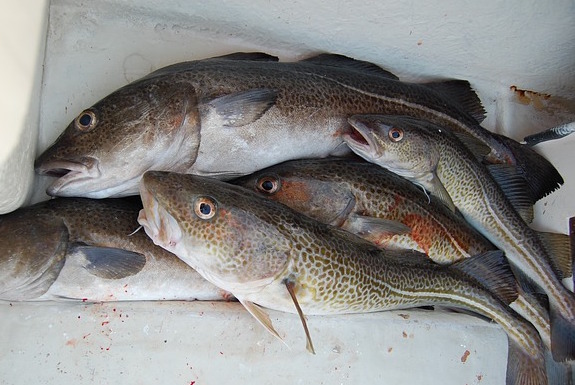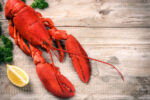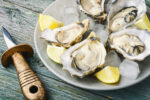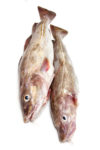
Cooking Codfish Heads, Tongues, and Sounds
I’ve seen a whole fish for sale in grocery stores, but not just the fish’s head. I never heard of a fish sound and didn’t even know they had tongues. The things I learn from reading old cookbooks!
The Sound is the swim bladder of many of the bony fishes. Fish that have a skeleton made of cartilage instead of bone don’t have bladders.
Fish Tongues are almost always attached to the bottom of the mouth, so they don’t protrude. Tongues have a jelly-like texture.
INFORMATION BELOW COMPILED FROM 1800s COOKBOOKS
COD FISH
They are in season from the beginning of December till the end of April. To be quite good, the fish should be thick at the neck, the flesh white and firm, the gills very red, and the eyes bright and fresh. When flabby, they are not good. The cod is generally boiled whole but a large head and shoulders contain all that is relishing, the thinner parts being overdone and tasteless before the thick are ready.
COD’S HEAD
The head and shoulders will eat much finer by having a little salt rubbed down the bone and along the thick part, even if eaten the same day. Tie it up, put it on the fire in cold water sufficient to cover it, and throw a handful of salt into it. Great care must be taken to serve it up without the smallest speck of black, or scum.
When cut, it should be done with a fish trowel. The parts about the backbone on the shoulders are the firmest and the best. Take off a piece quite down to the bone. With each slice of fish give a piece of the sound, which lies underneath the backbone and lines it, the meat of which is thin, and a little darker colored than the body of the fish itself. This may be got by passing a knife or spoon underneath.
About the head are many delicate parts, and a great deal of the jelly kind. The jelly part lies about the jaw, bones, and the firm parts within the head. Some are fond of the palate, and others the tongue, which likewise may be got by putting a spoon into the mouth.
Garnish with plenty of double parsley, lemon, horseradish, and fried smelts, if approved. If with smelts, no water must be suffered to hang about the fish, or the beauty and flavor of the smelts will be lost. Serve with plenty of oyster or shrimp sauce, anchovy and butter.
SAUCE FOR THE COD’S HEAD
Take a little white gravy, about a pint of oysters or cockles, a little shred lemon-peel, two or three spoonfuls of white wine, and about half a pound of butter thicken’d with flour, and put it into your boat or basin.
=================================================
BOILED CODS’ TONGUES
Soak the tongues overnight, change the water, and boil for ten minutes. Serve with Drawn-Butter Sauce.
DRAWN BUTTER SAUCE
Rub a piece of butter in a little flour, add two or three tablespoons boiling water. Shake continually over the fire without letting it boil, till it thickens.
FRIED CODFISH TONGUES
Wash the tongues, dip in cold milk and roll in seasoned flour. Fry in butter, and serve with tomato sauce.
=================================================
BOILED COD SOUNDS
Soak them in warm water half an hour, then scrape and clean them. If to be dressed white, boil them in milk and water. When tender, serve them up in a napkin, with egg sauce.
EGG SAUCE
Cut up six hard-boiled eggs, with salt and pepper to taste. Stir in a sufficient quantity of drawn butter, adding, just as you serve, minced onion, parsley, and thyme.
TO FRY CODS’ SOUNDS IN BATTER
Boil them as directed above until they are nearly done, then lift them out, lay them on to a drainer, and let them remain till they are cold; cut them across in strips of an inch deep, curl them round, dip them into a good batter, fry them of a fine pale brown, drain and dry them well, dish them on a hot napkin, and garnish them with crisped parsley.
BATTER
Make with one cup of milk, a pinch of salt, two eggs, one tablespoon of melted butter, one cup of flour and a teaspoon of baking powder. Sift the flour, powder, and salt together, add the melted butter, the eggs well beaten, and the milk. Mix into a very smooth batter, a little thicker than for griddle-cakes.
BROILED COD SOUNDS
Scald them in hot water, rub well with salt, pull off the dirty skin, and simmer them till tender. Then take them out, flour, and broil them. While this is doing, season a little brown gravy with pepper, salt, a teaspoon of soy, and a little mustard. Give it a boil with a little flour and butter, and pour it over the sounds.
COD SOUNDS RAGOUT
Having scalded, cleaned, and rubbed them well with salt, stew them in white gravy seasoned. Before they are served, add a little cream, butter and flour, gently boiling up. A bit of lemon peel, nutmeg, and the least pounded mace, will give it a good flavor.
=================================================
Have You Ever Eaten Codfish Heads? Please Leave a Comment Below.
=================================================




12 thoughts on “Cooking Codfish Heads, Tongues, and Sounds”
Growing up in the 40’s and 50’s in Newfoundland Codfish was a staple of our diet. It was relitavely easy to get and by far, the preferred dish. Back then people had time on their hands to acquire the delicies and the knowledge to properly cook it. Cod heads (just the cheek and tongue, bottom section) , sounds , tongues and especially hearts. Made the preferred meal. The fillet or body was ok, but easy to get and you had it more often. In today’s ,fast pace, the delicies are hard to get,as they are time consuming and expensive to produce, therefore ,processing plants discard it. I also understand that the cost would deter the market for those who would not be farmiliar with the product. Regardless of the cost, I have them when I can get them and thank the good Lord that I grew up when they were easily attained.
In Newfoundland, where I grew up in the 60’s, cods heads, tongues and sounds were discarded from fish processing plants. The plants were processing cod for salting, or filets for freezing. Locals would collect the heads for salting in brine, and cook the tongues and sounds right away for eating, much like discards from beef processing plants were often eaten by folks who couldn’t afford the finer cuts.
Growing up in Riverport Nova Scotia I remember eating sounds regularly in the fall season.A fish peddler would sell sounds in a 5 pound wooden pail and my mother would fry them up with pork scraps and boiled or mashed potatoes or Cumber salad.Fond memories.
What great memories. I didn’t live near any large body of water when I was growing up.
When I was growing up n N.C. My Dad loved to fish .. so we grew up eating fried “sounds” they were very gummy and sticky but had the most amazing taste! Hard to find at a fish market .. most people throw them away not knowing what they are or how delish they are 😍
I had never heard of “sounds” until I started going through old cookbooks for this blog. I lived in the Midwest, though, so we didn’t get to eat much fish. If I ever find them on a menu somewhere, I’ll try them.
I’m from a small fishing village on Prince Edward Island. My mother and I would eat cod heads frequently in the summer. She would just take the whole head and boil in salted water. I only ate the tongue and cheek area but I remember how good they were and how spectacular it looked as you’d have to have 4-5 heads each to make a meal so your dinner was served on a cookie sheet!
How interesting! I never heard of specifically eating cod heads until I saw it in the old cookbooks.
We had codfish tongues in Newfoundland where they still eat them but I only ate one because they weren’t cooked the way the expert we talked with at the fish processing place we went to said they should be. We had them at a restaurant and they were overly breaded. I think the tongues need to be cooked separately because of their size.
You’re brave to try them. Thanks for the explanation – maybe some day you’ll find some that are properly cooked.
Ok, technically this kind of stuff is fish but you won’t catch me eating anything like this anytime soon! I much prefer a nice fillet of cod done in breadcrumbs but it’s interesting to see what bygone generations of housewives cooked and served to their families. Different times, I suppose.
It seems odd to specifically cook the sounds and tongues separately from the rest of the fish. Maybe the texture affects the cooking time. And I’d hate to be given a fish head on a plate and see the eye. All these fish parts that aren’t the flesh make me squeamish.